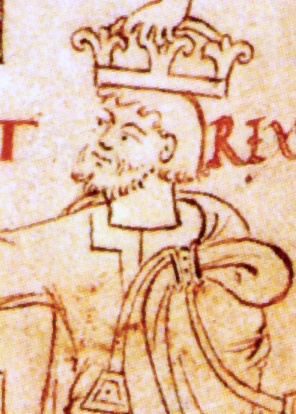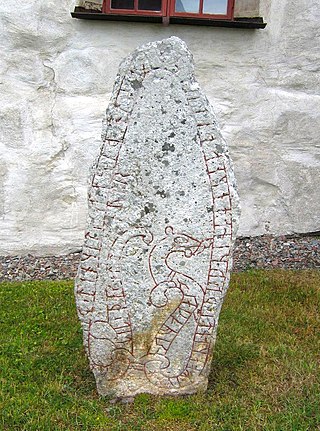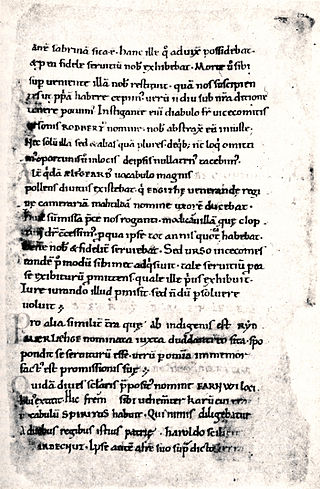
Æthelred II, known as Æthelred the Unready, was King of the English from 978 to 1013 and again from 1014 until his death in 1016. His epithet comes from the Old English word unræd meaning "poorly advised"; it is a pun on his name, which means "well advised".

Emma of Normandy was a Norman-born noblewoman who became the English, Danish, and Norwegian queen through her marriages to the Anglo-Saxon king Æthelred the Unready and the Danish king Cnut the Great. A daughter of the Norman ruler Richard the Fearless and Gunnor, she was Queen of England during her marriage to King Æthelred from 1002 to 1016, except during a brief interruption in 1013–14 when the Danish king Sweyn Forkbeard occupied the English throne. Æthelred died in 1016, and Emma married Sweyn's son Cnut. As Cnut's wife, she was Queen of England from their marriage in 1017, Queen of Denmark from 1018, and Queen of Norway from 1028 until Cnut died in 1035.

Sweyn Forkbeard was King of Denmark from 986 until his death, King of England for five weeks from December 1013 until his death, and King of Norway from 999/1000 until 1013/14. He was the father of King Harald II of Denmark, King Cnut the Great, and Queen Estrid Svendsdatter.

Cnut, also known as Canute and with the epithet the Great, was King of England from 1016, King of Denmark from 1018, and King of Norway from 1028 until his death in 1035. The three kingdoms united under Cnut's rule are referred to together as the North Sea Empire by historians.

Edmund Ironside was King of the English from 23 April to 30 November 1016. He was the son of King Æthelred the Unready and his first wife, Ælfgifu of York. Edmund's reign was marred by a war he had inherited from his father; his cognomen "Ironside" was given to him "because of his valour" in resisting the Danish invasion led by Cnut.
Lyfing was an Anglo-Saxon Bishop of Wells and Archbishop of Canterbury. He was abbot of Chertsey Abbey before becoming bishop at Wells. His appointment to Canterbury came at a time of Danish invasions of England, and he was unable to act as archbishop for a time due to Danish activity. When Cnut, the Danish king, became king of England, Lyfing likely consecrated the new king. Lyfing was known as a wise man and gave gifts to his church and oversaw repairs to his cathedral before his death in 1020.

Edward the Exile, also called Edward Ætheling, was the son of King Edmund Ironside and of Ealdgyth. He spent most of his life in exile in the Kingdom of Hungary following the defeat of his father by Cnut.
The House of Wessex, also known as the House of Cerdic, the House of the West Saxons, the House of the Gewisse, the Cerdicings and the West Saxon dynasty, refers to the family, traditionally founded by Cerdic of the Gewisse, that ruled Wessex in Southern England from the early 6th century. The house became dominant in southern England after the accession of King Ecgberht in 802. Alfred the Great saved England from Viking conquest in the late ninth century and his grandson Æthelstan became first king of England in 927. The disastrous reign of Æthelred the Unready ended in Danish conquest in 1014. Æthelred and his son Edmund Ironside attempted to resist the Vikings in 1016, but after their deaths the Danish Cnut the Great and his sons ruled until 1042. The House of Wessex then briefly regained power under Æthelred's son Edward the Confessor, but lost it after the Confessor's reign, with the Norman Conquest in 1066. All kings of England since William II have been descended from the House of Wessex through William the Conqueror's wife Matilda of Flanders, who was a descendant of Alfred the Great through his daughter Ælfthryth. Additionally, kings since Henry II have been descended from English kings from the House of Wessex through Henry I's wife Matilda of Scotland, who was a great-granddaughter of Edmund Ironside.

Thorkell the Tall, also known as Thorkell the High in the Anglo-Saxon Chronicle, was a prominent member of the Jomsviking order and a notable lord. He was a son of the Scanian chieftain Strut-Harald, and a brother of Jarl Sigvaldi, Hemingr and Tófa. Thorkell was the chief commander of the Jomsvikings and the legendary stronghold Jomsborg, on the Island of Wollin. He is also credited as having received the young Cnut the Great into his care and taken Cnut on raids. The Encomium Emmae, a document aimed at the movers and shakers of the Anglo-Scandinavian court in the early 1040s, describes Thorkell as a great war leader and warrior.

Eadric Streona was Ealdorman of Mercia from 1007 until he was killed by King Cnut. Eadric was given the epithet "Streona" in Hemming's Cartulary because he appropriated church land and funds for himself. Eadric became infamous in the Middle Ages because of his traitorous actions during the Danish re-conquest of England.
Uhtred of Bamburgh, was ruler of Bamburgh and from 1006 to 1016 the ealdorman of Northumbria. He was the son of Waltheof I, ruler of Bamburgh (Bebbanburg), whose family the Eadwulfingas had ruled the surrounding region for over a century. Uhtred's death by assassination was described in De obsessione Dunelmi and has been interpreted as the beginning of a blood feud. Lest he be confused with Uhtred, the son of Eadwulf I of Bamburgh, he historically has been referred to as Uhtred the Bold.
Eadwig Ætheling was the fifth of the six sons of King Æthelred the Unready and his first wife, Ælfgifu. Eadwig is recorded as a witness to charters from 993.

The Battle of Assandun was fought between Danish and English armies on 18 October 1016. There is disagreement whether Assandun may be Ashdon near Saffron Walden in north Essex, England, or, as long supposed, Ashingdon near Rochford in south-east Essex. It ended in victory for the Danes, led by King Cnut, who triumphed over an English army led by King Edmund Ironside. The battle was the conclusion to Cnut's invasion of England.

The Battle of Brentford was fought in 1016 between invading forces of the Kingdom of Denmark under Cnut and the defending forces of the Kingdom of England led by Edmund Ironside. The battle was fought as part of a campaign by Cnut to conquer England. The battle was a victory for the English, who nevertheless lost a large number of men.

The Anglo-Saxon period of the history of London dates from the end of the Roman period in the 5th century to the beginning of the Norman period in 1066.
Events from the 1010s in England.
Ælfgifu of York was the first wife of Æthelred the Unready, King of the English; as such, she was Queen of the English from their marriage in the 980s until her death in 1002. They had many children together, including Edmund Ironside. It is most probable that Ælfgifu was a daughter of Thored, Earl of southern Northumbria and his wife, Hilda.

The Danish House of Knýtlinga was a ruling royal house in Middle Age Scandinavia and England. Its most famous king was Cnut the Great, who gave his name to this dynasty. Other notable members were Cnut's father Sweyn Forkbeard, grandfather Harald Bluetooth, and sons Harthacnut, Harold Harefoot, and Svein Knutsson. It has also been called the House of Canute, the House of Denmark, the House of Gorm, or the Jelling dynasty.

Edmund Ætheling was a son of Edmund Ironside and his wife Ealdgyth. Edmund Ironside briefly ruled as king of England following the death of his father Æthelred the Unready in April 1016. Æthelred had spent most of his reign unsuccessfully resisting incursions by Danish Vikings, and as king Edmund Ironside put up a strong fight until his death in November 1016, when the Viking leader Cnut became the undisputed king of all England.

In the autumn of 1016, the Danish prince Cnut the Great (Canute), supported by Eiríkr Hákonarson, successfully invaded England. Cnut's father, Sweyn Forkbeard, had previously conquered and briefly ruled England for less than five weeks.













